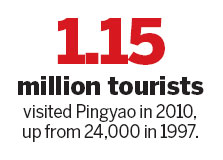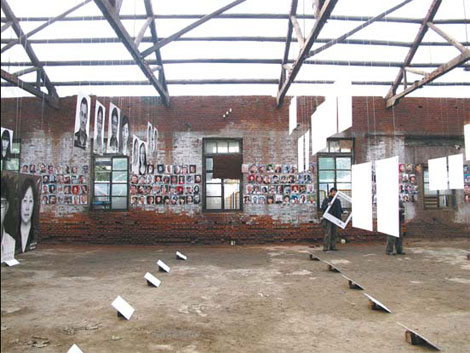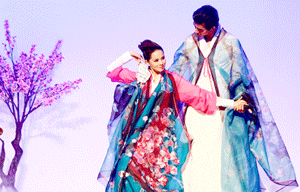Authentic to the end?
Updated: 2011-11-15 07:56
By Zhang Zixuan (China Daily)
|
|||||||||
|
A panoramic view of the World Heritage site, Pingyao old town. Provided to China Daily |
Questions of modernity and history crash into one another in Shanxi province's Pingyao and are - sometimes, literally - pulling the place apart. Zhang Zixuan reports.
The challenges facing Shanxi province's ancient city of Pingyao are perhaps best embodied by the black tarp made lumpy by the jumble of bricks it covers - the remains of a house on West Street that local vendors say collapsed five years ago.
Two adjacent shops elsewhere in the city also tumbled down by themselves on Sept 20, locals say.
These buildings' implosions touch on just one of the questions surrounding Pingyao's competing concerns - issues of restoration and preservation; of commercialization and inhabitation; and of historical lifestyles and modern living standards.
The State Council proclaimed Pingyao old town as a National Historical and Cultural City in 1986. And the 600-year-old birthplace of Shanxi's merchant culture became China's first entire city inscribed on UNESCO's World Heritage List in 1997.
"Pingyao is an exceptionally well preserved example of a traditional Han Chinese city, founded in the 14th century," the UNESCO statement says.
"Its urban fabric is an epitome of the evolution of architectural styles and town planning in imperial China over five centuries. Of special interest are the imposing buildings associated with banking, for which Pingyao was the center for the whole of China in the 19th and early 20th centuries."
The wall came down
That was before the 2004 collapse of a stretch of the city wall. The event highlighted questions surrounding Pingyao's Ming (1368-1644) and Qing (1644-1911) dynastic structures - namely, concerns about preventing natural decay without shedding authenticity through renovations and reconstructions.
The collapse of ancient constructions has been an issue for the past half a century, retired construction worker Fan Laiyuan says.
The 79-year-old, who claims to know "every brick" in the ancient city, says the phenomenon has been part of life since the 1940s.
"It's a combination of age and rainwater seeping into the rammed earth and dissolving the mortar," he says.
"We would tear the damaged structures down to rebuild them. We would ram the earth again to ensure they looked like they had originally and sometimes add new bricks when there weren't enough original ones."
Pingyao County Bureau of Cultural Heritage director Jia Zhongzhao admits several damaged or destroyed buildings have been waiting for or undergoing repair for years.
He says about a dozen regulations on protection have been issued since 1998, and more are on the way.
Fan proclaims a "light touch" philosophy to rebuilding and renovation.
"Fake ancient buildings have no historical value at all," he says.
"There are fewer and fewer unadulterated buildings as time goes on. Call me 'old guard', but I believe we shouldn't change them anymore."
Shanxi traditional architecture scholar Chai Zejun says authenticity in necessary renovations can be better assured by using the original materials and construction methods while replicating the forms as precisely as possible.
"Every time you modify or repair a building, you've changed it," the 76-year-old says.
He says the entire city should be photographed to document its original forms.
Such preservation is particularly important, he believes, for such exchange shops as Rishengchang, which is believed to be China's first draft bank.
Private versus public
But questions become murkier when considering where responsibility should fall when considering private versus public property.
"The government takes responsibility for repairing protected monuments, while residents should take care of their own houses," Jia says.
"But for some reasons - mostly family or ownership disputes and poverty - these residents aren't really doing it."
Some residents, Chai says, have modified their homes in such ways as installing large framed windows for better lighting.
Chai says this is understandable, although problematic.
"There are some conflicts between protecting the ancient city and improving residents' livelihoods," he says.
Expert Committee of National Historical and Cultural City Protection secretary general Wang Jinghui believes there must be compromises on this issue.
"Pingyao must be multifunctional so that it not only serves the needs of preservation and tourism but also of the people who call it home," says the 71-year-old, who is also the former deputy director of the Ministry of Housing and Urban-Rural Development's urban planning department.
He believes preservation is not only to protect what has been built but also to document the dynamics of change throughout development's course - as long as the style remains consistent.
Residents such as 74-year-old Hao Tingshou, who has lived at No 4 West Wudaomiao his whole life, says many of the changes he has seen have made life better.
These include putting flagstones on the previously dirt roads, supplying water and electricity via underground pipes and wires, and generally improving local sanitation.
Jia adds that high-emission heavy industries have been relocated out of town.
The Diesel Engine Factory, for example, has been transformed into an art zone, hosting such events as the Pingyao International Photography Festival.
But industry isn't the only thing being relocated.
Residents, enterprises and government departments are also being moved out.
This is partly because the tourist influx has increased 48-fold since 1997 - growing from 24,000 that year to 1.15 million in 2010.
So, the local government has removed about 100 companies, government departments, schools and hospitals - in addition to shaving 15,000 residents off the local population tally of 50,000.
The relocation is ongoing, Jia says.
"The ideal number is about 20,000," he says.
Preserving local lifestyles

But the relocation could starve the local culture of its vitality if not moderated, director of the State Administration of Cultural Heritage's ancient architecture expert team Luo Zhewen warns.
The 87-year-old points to Yunnan province's Lijiang old town - also a World Heritage Site - as a place where this has happened.
"If the local people are gone, the local lifestyle dies," he says.
And residents like Hao say they don't mind using a public toilet for the rest of their lives.
His three cave dwellings indicate his poverty, but he says he doesn't want to leave them.
"Their structures are as strong as always," he says.
"I've never had to fix a leaky roof or do any kind of repair to my homes. And my friends all live here."
He rides his bicycle halfway across town to meet his old buddies at 2 pm every day for chats in the sunshine at the city wall's base.
His four grown children, however, have voluntarily moved into high-rises outside of the ancient city.
Hou Meiying, 70, says staying in her family's home, which has been in the family for 10 generations, is important to her bloodline's legacy.
The house is larger than others in the neighborhood and is perfectly preserved - that is, aside from the stone lion door statues and woodcarvings on a beam that were damaged during the "cultural revolution" (1966-76).
"It has never had a single rat's hole throughout the years," Hou says.
"I'm not leaving."
Questions of commerce
Architecture scholar Chai believes concerns about Pingyao's over-commercialization are unfounded.
"It was flourishing businesses that gave Pingyao its place in history," he says.
"The shops aren't a problem, as long as they remain small."
Fan, the 79-year-old resident, agrees.
"The four main streets have been bustling since the city was born," he says. "The other areas have remained quiet and livable."
But Fan says the shops that are there now shouldn't be replaced by other businesses.
He recalls being displeased when a souvenir shop replaced a silk store, and a hotel took over the space previously occupied by a pharmacy.
But 22-year-old Hou Maodou, who has been working in the 100-year-old Changxing Shoe Shop for eight years, says he doesn't worry about over-commercialization.
Hou says the problem is the opposite - it's hard to make money, especially in the winter.
On the best days, Hou's shop can sell about 20 pairs of handmade cloth shoes at 50 yuan ($7.88) a set.
"It used to be that only rich people came here," he says.
"But now, most tourists are middle-class."
The service industry also struggles, unlicensed tricycle taxi driver Qiao Qiliang says.
The 37-year-old moved into the ancient city from a nearby village three years ago hoping to improve his income.
However, aside from during national holidays, he has found business to be slow, especially after the government started a transport system of electronic carts in 2009.
"But at least I can pay my son's tuition," Qiao says.
Chai says he retains hope for both the retention of the local culture and prosperity.
"Pingyao is a huge treasure," he says.
"It will continue to flourish as along as the city retains its authenticity."
|
Pingyao resident Hao Tingshou (left) enjoys the sunshine with his friends in the old city. Photos by Zhang Zixuan / China Daily |
|
The Diesel Engine Factory in the old city has been turned into an art zone. |














